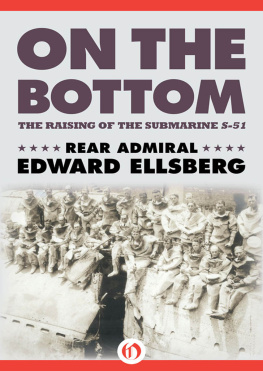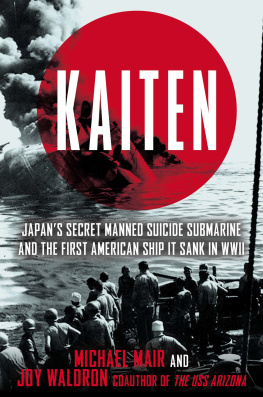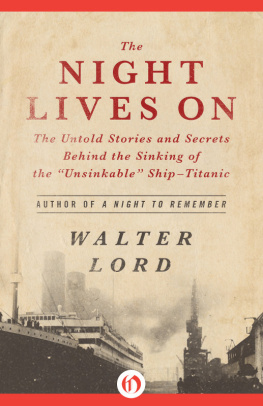On the Bottom
The Raising of the Submarine S-51
Rear Admiral Edward Ellsberg

to
THE MEN OF THE U.S. NAVY
C ONTENTS
I
C OLLISION
On a dark September night, with a cold breeze whipping up a choppy sea about fifteen miles to the eastward of Block Island, the steamship City of Rome plowed northward towards Boston. Four bells struck. The new lookout took his post in the bow, sheltering himself from the wind by crouching low behind the bulwark.
Light on the starboard bow!
The mate on the bridge acknowledged the report, and sent word to the captain in his cabin. The City of Rome kept on her course. The helmsman went below for an inspection, leaving the mate, who relieved him at the wheel, alone on the bridge.
The lookout watched the light; a single white point perhaps five miles off. Gradually it grew brighter as they overhauled it, but its bearing remained constant, broad on the starboard bow. Twenty minutes went by. The light grew very bright. The lookout gazed inquiringly at his own bridge. The other ship, whatever it was, had the right of way, but the City of Rome made no move to pass astern.
They were very close now. The strange light was almost under their bow when a red side light flashed into view close to the white one. Simultaneously the mate started to swing the ship to port and blew his whistle frantically.
Hearing the noise, the captain rushed to the bridge, took a hasty glimpse at the lights on his starboard bow, and then, disregarding their proximity, ordered his ship swung to starboard towards the lights, trying to pass astern of them.
For one brief second the lookout, peering over the side, saw the dim outline of a submarine as they swung towards her, then came the crash.
The submarine, struck just forward of its conning tower, rolled drunkenly to starboard, then fell away as the City of Rome slipped by. The captain of the submarine appeared on her bridge. The startled passengers on the steamer, looking over the side, caught a brief glimpse of his face looking up, heard one agonized cry from below:
For Gods sake, throw us a line!
The City of Rome, speed unchecked, rushed on by.
II
O N THE S-51
Inside the S-51, except for the few men on watch, the crew were turned in, closely packed in their bunks in the battery room. On the little bridge, two officers and two seamen, heavily clothed, conned the ship;course northwest, speed eleven and a half knots.
A cold spray broke over the low-lying hull. All hatches were secured, except the single one leading from the bridge down through the conning tower to the control room. The Diesel engines were drawing air from an intake valve just under the bridge.
Lieutenant Dobson, commanding the S-51, dropped into the control room to study the charts. He was closing on Block Island; in another hour he would head out to sea again to continue his twenty-four-hour reliability run.
Shortly after 10 P.M., the lights of a steamer were sighted on their port quarter. They gradually drew closer. The watch on the S-51s bridge examined her. They had the right of way; under the International Rules of the Road at Sea the S-51 was required to maintain its course and speed. As their own stern light was plainly visible to the other ship, they felt no alarm. The steamer would shortly change course and pass astern of them.
They watched as the City of Rome drew closer and closer, but saw no change in her bearing. A few more minutes and the steamer was looming over their port quarter, very close now. She was evidently going to run them down in spite of the rules. They must look out for themselves.
Hard right! The submarines rudder went over and she started to swing to starboard. With relief her officers noted that the steamer, almost on top of them, was starting to turn to port, away from them, as she commenced blowing her whistle. Then to their horror they saw the steamer change her direction, and swing to starboard right for their side. The next instant, there was a terrific crash as the stem of the City of Rome struck the battery compartment.
The S-51 was thrown violently to starboard. Through a huge hole in her port side, water started to rush into the room, filled with sleeping men.
Dewey Kyle, machinists mate, flung by the shock from an upper bunk into the narrow starboard passage, found himself in water up to his waist when he hit the deck. Running aft through the battery room, the water followed as he stepped through the door into the control room. A few seamen, clothed as he was, only in their underwear, were climbing the ladder to the conning tower. The men on watch in the room stood by their controls; a chief petty officer there, who might easily have left, helped Kyle up the ladder but himself stayed below at his station.
Kyle scrambled up through the little conning tower and out the hatch to the bridge; as he did so he found himself swimming. The submarine had disappeared beneath his feet. He was the last man out.
A dark hull, looking mountain high, was disappearing in the darkness. The water was cold, the choppy sea made swimming difficult. Kyle thanked his luck he was not loaded down by clothing. Nearby he could see eight other swimmers,his captain, the lieutenants who had been on watch on the bridge, the helmsman, the quartermaster, a few others. They were struggling desperately to rid themselves of their heavy clothes so they could swim.
One by one they vanished in the dark water, till only two beside Kyle remained afloat. Like him, Geier and Lyra had been catapulted from their bunks by the collision; being nearer to the control room they had escaped before him; now only these three unclothed swimmers of the crew of thirty-six remained on the surface.
Desperately they swam on in the wake of the steamer; after nearly an hour in the water, a small boat picked them up, and brought them aboard the City of Rome. In a few minutes, ship and survivors were on their way to Boston.
Some hours later, when nearing the entrance to the Cape Cod Canal, the City of Rome reported the accident by radio.
III
R ESCUE E FFORTS
COMMANDER CONTROL FORCE TO COMMANDING OFFICER U.S.S. Falcon:
S-51 reported in collision latitude 41 12 N., longitude 71 15 W. Falcon proceed to scene immediately prepared for rescue work.
I handed the radio message back to Lieutenant Hartley. Already he was casting off his lines to the pier, and in a few minutes the Falcon was standing out of the New York Navy Yard and heading up the East River towards Long Island Sound.
The delayed report from the










